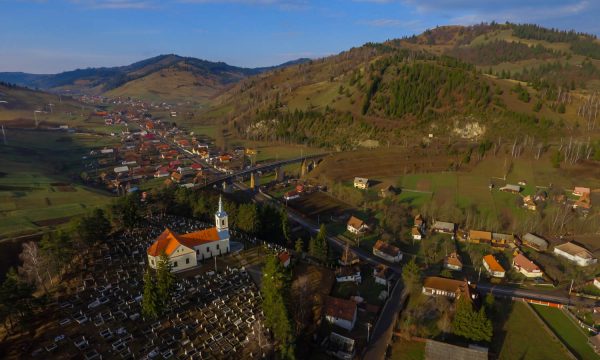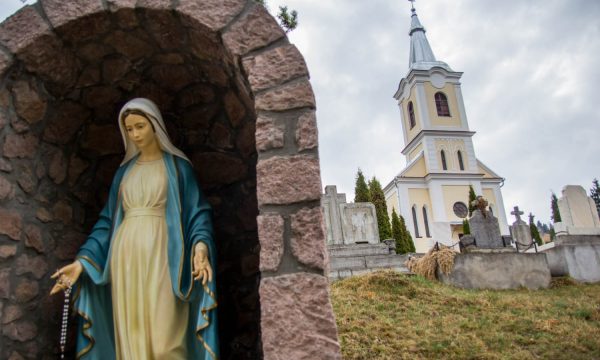Legend
The Saint Ladislaus tradition in Ghimeș (Hu: Gyimes) region was shaped primarily by the Szekler, mainly Ciuc (Hu: Csík) region folklore, as the Csángó settlers took their former traditions with themselves to their new residence. The two ecclesiastical buildings built on the ridge that separates Ciuc and Ghimeș, the Saint Ladislaus chapel from Păgânul Peak (Hu: Pogányhavas) and the Holy Spirit chapel from Frumos Mountain (Hu: Széphavas) symbolized the sacral nature of the border.

They also served as reminders of the Saint King, protector of borders. This is why after the destruction of the chapel from Păgânul Peak, Saint Ladislaus became increasingly associated with the chapel of Frumos Mountain, which was still standing in the 19th century. From the beginning of the 1990s, cultivating their medieval heritage, the congregation of Lunca de Sus celebrates Saint Ladislaus’ Day at the medieval ruins, where a new, circular chapel dominating the surrounding landscape was built in 2014. This chapel and its surroundings were the main locations of the Lunca de Sus Csángós’ legends of Saint Ladislaus as well. According to the stories recorded in many text versions, the Saint King fought in the mountains with the heathen and the foreign invaders. The memory of these battles is preserved by the names of some surrounding heights (Pagan’s Peak, Tartar Mountain) and the ramparts on the eastern side of Frumos Mountain, which are also attributed to King Ladislaus.

The eminently varied Saint Ladislaus cycle mentions the speaking magic steed of the king, the horse that solidified the stones and drained the waters of the Ciuc Basin and the Ghimeș pass. The tradition of Shrove Tuesday, closing a carnival period, is also related to him. Almost novelistic is the story of the king’s disguised homecoming, which is only known from Ghimeș and Moldova. According to the tradition of Lunca de Sus, Saint Ladislaus built the Chapel of Frumos Mountain in memory of the victory over the enemy. Near the chapel, the Küpüs well in the side of Păgânul Peak is also related to him: he made it, and his horse’s foot left a trace in the stone next to the spring, where the horseshoe still can be seen. Traces visible on rocks are connected to St. Ladislaus elsewhere in Ghimeș as well. A horseshoe is also told of on the border of the Cădărești (Hu: Magyarcsügés) and Coșnea (Hu: Kostelek) villages from Hárompatak region, and in the impressive rock above the spring of Bükkhavas creek, while on the side of the Bagolykő rock there is a trace of the sacred king’s backside and two feet in the stone. According to the legends of the local Csángós, the army of Saint Ladislaus struck the enemy under Bagolykő rock and the legendary king watched the battle in the valley seated on this rock.
Natural Heritage
Lunca de Sus and the surrounding territories are almost entirely part of the Ciuc Mountains (Hu: Csíki-havasok) nature reserve. The history of the development of the meadows that are so characteristic of the mountainous Ghimeș (Hu: Gyimes) region goes back to hundreds of years ago, and the land management of the people of this historical region made the grasses in the area the most species-rich in Europe. The originally forested landscape has been cultivated and transformed into meadows and lawns. The abandonment, division and disappearance of these alpine meadows have endangered these complex ecosystems and they have become a protected habitat within the European Union.

The characteristic plant species of these environments include the black false hellebore (Veratrum nigrum), the bachelor’s button (Centaurea mollis), Cypripedium calceolus, a lady’s-slipper orchid, the stemless gentian (Gentiana acaulis) and various clovers such as the Trifolium alpestre, Trifolium pannonicum and Trifolium montanum. The Orchidaceae are also represented by several species, the heath spotted-orchid (Dactylorhiza maculata), the fragrant orchid (Gymnadenia conopsea) and the military orchid (Orchis militaris), a protected plant, among others. Their roots are sometimes used as aphrodisiacs by the locals.
Another notable flower of the meadows near Lunca de Sus is the snowdrop (Galanthus nivalis), which grows plentifully in the favourable areas soon after winter. However, this messenger of the spring is endangered by being picked in large quantities and is now a protected species.
The diverse flora of these meadows contributes to the variety of insects found here, since the lives of many species depend on the presence of one or another plant. Besides the plant and insect life, vertebrate animals are also present in these grasses. One such animal is the common frog (Rana temporaria). These frogs can travel up to 10 km in the flooding creeks to their breeding grounds, where hundreds or even thousands of them gather.
